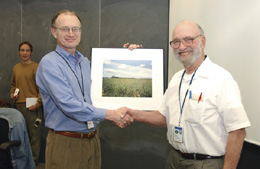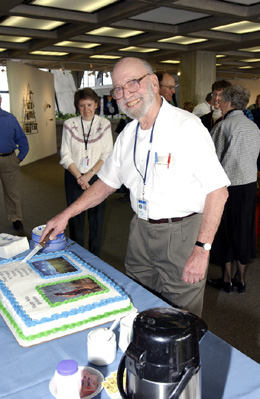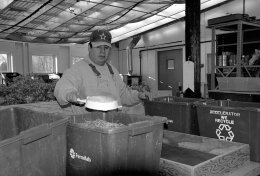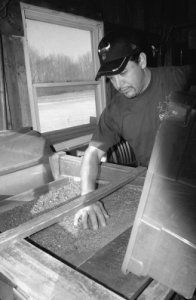 |
|
"I have spread my dreams under your feet;
Professor Prairie by Elizabeth Clements Freedom, serenity, history, endurance – these are just a few of the words that come to mind when describing the feeling of a prairie. It is a feeling that Dr. Robert Betz, the inspiration behind the Prairie Restoration Project at Fermilab, knows well. In 1973—almost thirty years ago—Betz, along with Raymond Schulenberg, of Morton Arboretum, and some dedicated Fermilab employees, drew up the first plans for the nine acres of land that would become the Prairie Restoration Project. Thirty years later the Fermilab prairie is flourishing with over 1,100 acres of restored prairie and no sign of anything slowing down yet, including Betz. In addition to celebrating three decades of a successful prairie restoration, Betz, also known as Professor Prairie, has another occasion to celebrate this month, his 80th birthday.
THE CELEBRATION
Fermilab Director Michael Witherell presented Betz with a Certificate of Appreciation in recognition of the Prairie Restoration Project and a poster-sized image of a prairie burn. “Hardly anybody, other than [founding director] Bob Wilson, has ever left as big an imprint on Fermilab as Bob Betz,” said Witherell. Expressing appreciation and gratitude for all of those who had helped the prairie become what it is today, Betz said, “I’m so happy. I would do it for nothing.” Betz remembered passing by Fermilab in its early days—1971—and hearing a rumor that Robert Wilson, the founding Director of Fermilab, had contacted the Morton Arboretum about landscaping plans for the lab’s 6,800 acres of land. Betz, who had been searching for a place to build a big pre-settlement prairie, knew that Fermilab would be the perfect place. He contacted Wilson, who had only one question: how long would it take to reconstruct this prairie? Betz admitted that this had never been done before, so he really didn’t know. It might take 10, 20, 30, 40—he stopped at 100 years. Wilson replied, “We should start this afternoon.” And they did.
BEHIND THE SCENES
Martin Valenzuela and Joe Trevino, of Fermilab’s Roads & Grounds department, understand first hand the amount of work that a prairie requires. Inside a greenhouse in the Fermilab village, the sweet aroma of herbs and wildflowers welcomes visitors in from the winter chill. Barrels and barrels of plants, collected by volunteers at the prairie harvests in the fall, occupy every inch of space. Betz makes regular visits to the greenhouse. “I enjoy it when he is around,” said Trevino. “Dr. Betz takes his time to explain the types of plants and where they come from. I always learn from him.” Valenzuela and Trevino have the harvesting of seed down to a science. Sifting mills and air pressure mills extract the seeds, which can be minuscule, from the dust and other entities that make up a plant. Sanding blocks and ordinary kitchen strainers are also used to sort out the pure seeds. Once the seeds are considered to be at least 90% pure—100% for rare plants—batches are stored in a walk-in freezer adjacent to the greenhouse. Valenzuela explains that the freezer reenacts winter for the seeds, keeping them cool and dry. In the spring, the seeds are planted in the tracks of prairie burns. “One of the key things that Dr. Betz taught us about the prairie is that you can’t just throw seed in one place and have it grow,” said Valenzuela. “It depends on so many things. It is really an experiment.”
THE BIRDS AND THE BEES
(BISON AND BUTTERFLIES TOO!) “One has to start with the plants,” said Tom Peterson, a Fermilab engineer and ELM Committee member. “Prairie animals, such as insects, can only be introduced after the plants are established because the animals depend on them. Several prairie butterfly species, like the large and beautiful Regal Fritillary, which were once common and widespread in Illinois, are now extremely rare due to the destruction of the prairies. We hope that, eventually, prairie restorations like Fermilab’s will be able to support some of these long-absent prairie animal species.” Betz’s next goal for the Fermilab prairie is to reintroduce the original prairie pollinators—bees and wasps. A bee sting or two (“They only hurt for a minute,” he said) is not enough to scare Betz from introducing a catalyst to help the flowers grow. Betz would also like to introduce the prairie earthworm to Fermilab. This whitish-pink earthworm is extremely fragile and can only survive in a specific type of prairie soil. The more often these critters are introduced to the prairie, the closer the project will be to completion.
BLUE (CHEESE) MOON Two or three years later, on a morning in July, Betz watched the sun rise over the prairie plants that he had restored in a cemetery. One of the caretakers drove up the road and got out of his truck to admire the scene. The caretaker told Betz that when he had first heard all of these ideas about restoring a prairie with plants that he had never heard of, he never believed that it could be done. “ ‘Now,’ he said, ‘if you told me that the moon was made out of blue cheese, I would believe you,’ ” said Betz. “That was one of the nicest compliments I ever received.” Happy Birthday, Professor Prairie.
ON THE WEB: |




